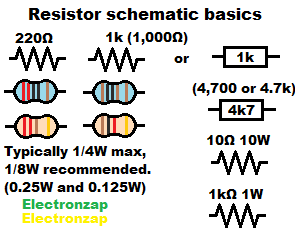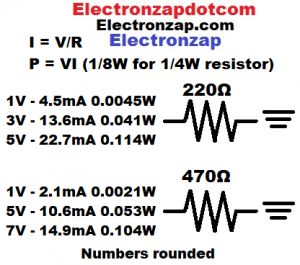Table of Contents
The 220Ω resistor is commonly seen in schematics and is usually included in resistor kits. Most resistors are rated for 1/4W. So, you can generally assume that a 1/4W (0.25) resistor is being referred to unless it is noted otherwise. Remember that the wattage rating is a maximum wattage. It’s best to stay half way below that.

- 220Ω resistors are commonly seen in 5V circuits.
- It will keep a series indicator LED below 20mA when supplied with 5V
- Even if there is the full 5V across it, the wattage of the 220Ω resistor will be 5V/220Ω = 0.0227A… 5V x 0.0227A – 0.1135W of power it needs to dissipate. That’s slightly less than the recommended limit of 1/8W (0.125W) when using a 1/4W (0.25W) resistor. So, it is safe to put 5V directly across a 220Ω 1/4W resistor.
-
- You will probably not have values that start with just a 2 Such as, 0.2Ω, 2Ω, 20Ω, 200Ω, etc. You will probably have many values that start with one though (0.1, 1, 10, 100, 1000, 10,000 etc.), which you can wire in series to add up their resistance.
- Resistors used to be a lot more expensive and a lot less accurate. For a while, 10 to 20% tolerance was typical. Later on 5% tolerance was the most common. Whereas now you are most likely to have 1% tolerance resistors. So early numbering systems spaced out a few values, which circuit builders could combine in series and parallel as needed to get the value they want. Therefore, many resistor values start with 22 instead of just 2. You will probably have some or all of the following values if you buy a resistor kit with many values… 0.22Ω, 2.2Ω, 22Ω, 220Ω, 2200Ω, etc. You can put two 100Ω resistors in series for 200Ω if you need it. Resistors values that start with 1 (followed by all zeroes) are the most commonly available values.

Current through a resistor is linear. If you double the voltage across a resistor, then twice the current will flow through it. If you triple the voltage, then you will get 3 times the current flowing through it.
Wattage is not linear. Wattage is voltage times current. If you put twice the voltage across the resistor, it will pass twice the current. So, those 2 values will multiply for 4 times the wattage (heat) generated.
If you put 3 times the voltage across a resistor, you will get 3 times the current flowing through it, and therefore 9 times as much heat will be generated.
Values given below (and most other places on this site) are rounded off.
| Voltage across 220Ω | Current | Wattage |
|---|---|---|
| 1 | 4.5mA | 4.5mW |
| 2 | 9.1mA | 18.2mW |
| 3 | 13.6mA | 40.1mW |
| 4 | 18.1mA | 73mW |
| 5 | 22.7mA | 114mW |
To be added:
- Table
- Series
- Two series 220Ω protecting red LED from 9V
- Parallel
- Series and parallel (higher wattage resistor of the same value 2S2P)
- 220Ω makes red LED bright without exceeding 20mA
Common resistor values:
Related pages:
To support this site, check out the following links:
- Check out my YouTube videos! https://www.youtube.com/c/Electronzap/videos
- Products I used in my videos or otherwise think look like a good buy. As an Amazon associate, I earn from qualifying purchases. https://www.amazon.com/shop/electronzapdotcom
- Information on this site is not guaranteed to be accurate. Always consult the manufacturer info/datasheet of parts you use. Research the proper safety precautions for everything you do.
- Electronzap is a participant in the Amazon Services LLC Associates Program, an affiliate advertising program designed to provide a means for sites to earn advertising fees by advertising and linking to amazon.com.